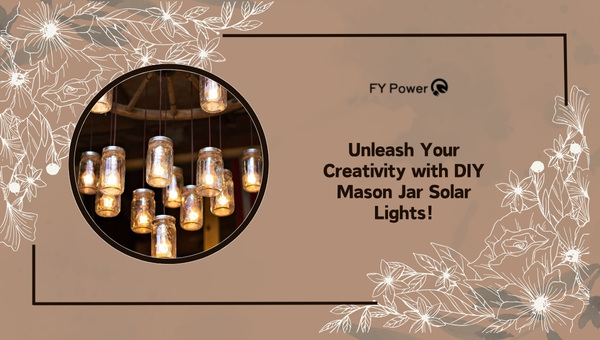Want to revitalize your shady garden spots? Explore 25 innovative garden designs crafted for shaded environments. Transform those dim areas under trees or in corners of your yard into vibrant, green retreats. Discover inspiring ideas to craft a stunning, lush oasis in your garden. Let’s explore these possibilities and make your shaded areas truly remarkable!
Integrating Architectural Elements
Elevate your shade garden design with architectural features like gazebos. This image presents a beautiful gazebo nestled in vibrant greenery, offering a tranquil garden escape. It acts as both a stunning focal point and a comfortable space for relaxation or socializing. The gazebo’s design harmonizes with the natural landscape, perfectly integrating with the surrounding plant life.
Choosing Foliage: Textures and Colors

Crafting a captivating shade garden hinges on selecting the perfect foliage. Observe the dynamic interplay of hues and textures in this visual. Lush greens, gentle yellows, and bold reds combine to form a breathtaking display. This vibrant tapestry can illuminate even the darkest areas of your garden, creating a welcoming and visually appealing space.
Combining diverse leaf forms enhances visual appeal. Observe the contrast between the wide, textured leaves and the finer foliage close by. This pairing results in a vibrant scene, captivating attention and encouraging closer inspection.
Employing plants with vibrant variegation is a great way to enhance light reflection. The striking reds and oranges create a stunning contrast against the deep greens. This visual dynamic boosts your garden’s charm and maintains its vibrancy year-round.
When planning your garden, remember its overall theme. Select plants with complementary colors and textures for a unified design. Consider color interactions carefully. Layering various shades can create a balanced and calming atmosphere.
Creating a Pathway in the Shade
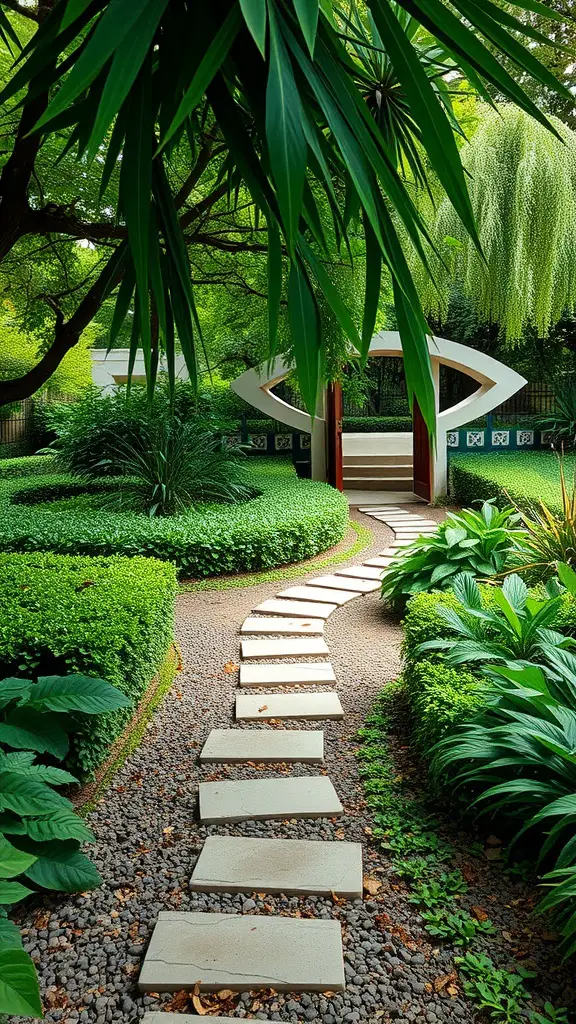
Crafting a walkway in a shady garden offers both functionality and aesthetic appeal. This image presents a charming, curved path built with stepping stones. It gracefully leads the viewer’s gaze through a vibrant, verdant setting. Lush greenery borders the path, enhancing the scene’s depth and visual interest.
Opting for organic elements, such as stone or gravel, creates a charming, earthy vibe. It seamlessly integrates with your garden’s flora. This pathway isn’t merely practical; it sparks curiosity. It beckons you to uncover your garden’s secret spots.
Curved pathways enhance visual appeal and create a welcoming atmosphere. Observe how the subtle bends guide you toward the delightful feature in the distance. This design element introduces an intriguing sense of discovery, enticing you to explore the garden further.
Consider pathway lighting for safety and ambiance. Gentle uplights or solar lanterns improve visibility at night. They also create a welcoming atmosphere. Careful planning transforms your shaded pathway into a garden highlight.
Incorporating Shade Tolerant Flowers
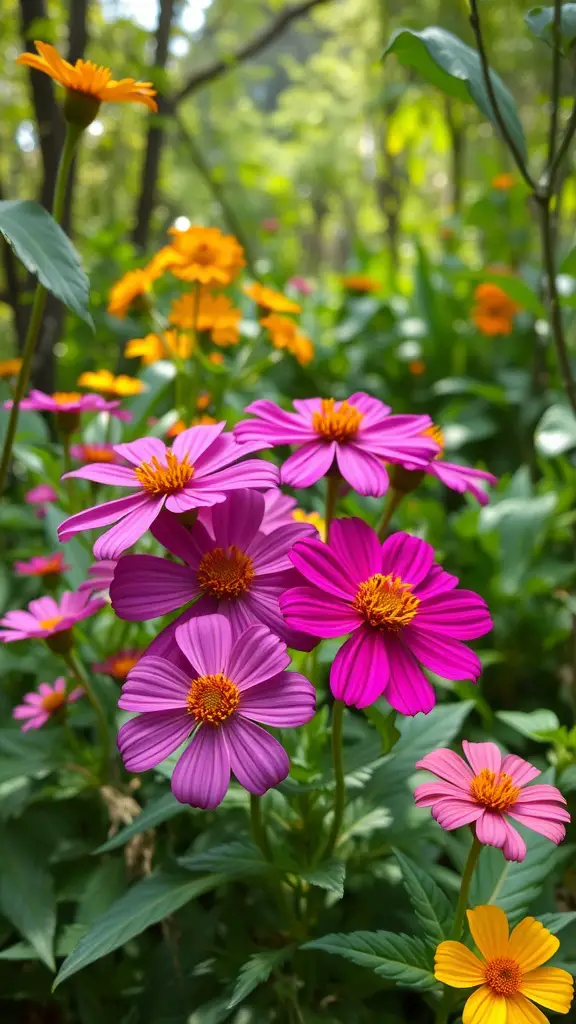
Crafting a stunning shade garden? Selecting the perfect flowers is key. This image highlights vibrant blooms flourishing in low-light environments. They’ll inject vibrant color into your garden. Observe the pink and orange blossoms; they create a joyful ambiance, even without direct sunlight.
These shade-loving flowers offer beauty and create a welcoming atmosphere. Consider adding astilbe or hostas. These plants enhance your garden’s appearance and soften its borders. They perfectly complement the vibrant blooms.
Try arranging flowers in groups to form eye-catching focal points, just like in the picture. This technique grabs attention and builds a unified design. Adding various heights and textures will also boost the visual appeal of your shady spots.
Embrace the charm of shaded areas by planting flowers that thrive in low light. A diverse selection of colors and forms can turn any dim spot into a welcoming haven. Whether you have a compact balcony or a large garden, remember that shade doesn’t equal dullness! Consider these options for a vibrant, shaded garden in 2025.
Water Features for Tranquility
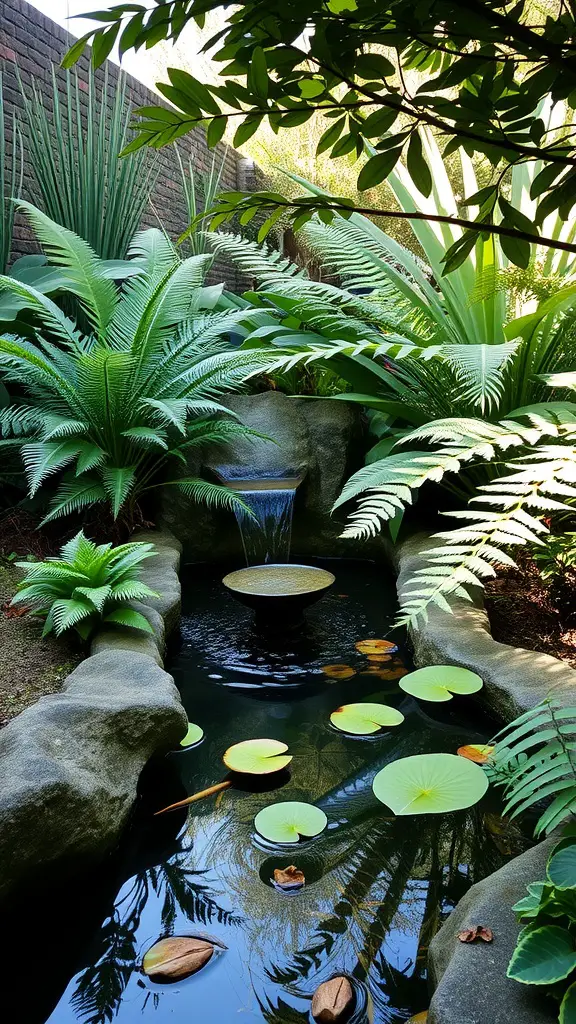
Water elements elevate any shaded garden into a tranquil sanctuary. The picture showcases a beautiful pond embraced by vibrant foliage. The soft, flowing water produces a relaxing melody, perfect for unwinding and de-stressing in 2025.
Lily pads now grace the pond’s surface, introducing vibrant hues and captivating details to the tranquil setting. These features attract local wildlife, like frogs and various bird species, further enriching the garden’s organic ambiance.
Adding a compact fountain, similar to the one pictured, is an easy upgrade for any garden. The gentle flow of water creates a calming ambiance and a captivating visual element.
Enhance your 2025 shade garden by positioning water features close to seating. This creates a tranquil space for relaxation and social gatherings, offering both visual and auditory pleasure.
Using Ground Covers Effectively

Ground covers are essential for thriving shade gardens, as seen in the picture. Verdant foliage blankets the ground, forming a stunning carpet that flourishes in dim light. These plants boost visual appeal and greatly improve garden health.
Ground covers excel at weed control, a major advantage. In shady spots where flowers and bigger plants may falter, ground covers step in. They occupy empty spaces, stopping weeds from dominating. This helps your desired plants thrive without battling for resources.
The image showcases ground covers thriving under towering trees. This layered approach enhances the landscape’s visual appeal and complexity. When selecting ground covers, factor in their growth patterns and compatibility with current vegetation. Certain varieties spread rapidly, whereas others exhibit slower growth.
Furthermore, these plants combat soil erosion, particularly on slopes. Their root systems bind the soil, preserving its structure and minimizing runoff. This is crucial in shaded locations where rain easily erodes exposed soil.
Furthermore, ground covers establish a beneficial microclimate. They conserve soil moisture and offer shelter for helpful insects. This fosters biodiversity, essential for a thriving garden ecosystem in 2025.
Layering Plants for Depth
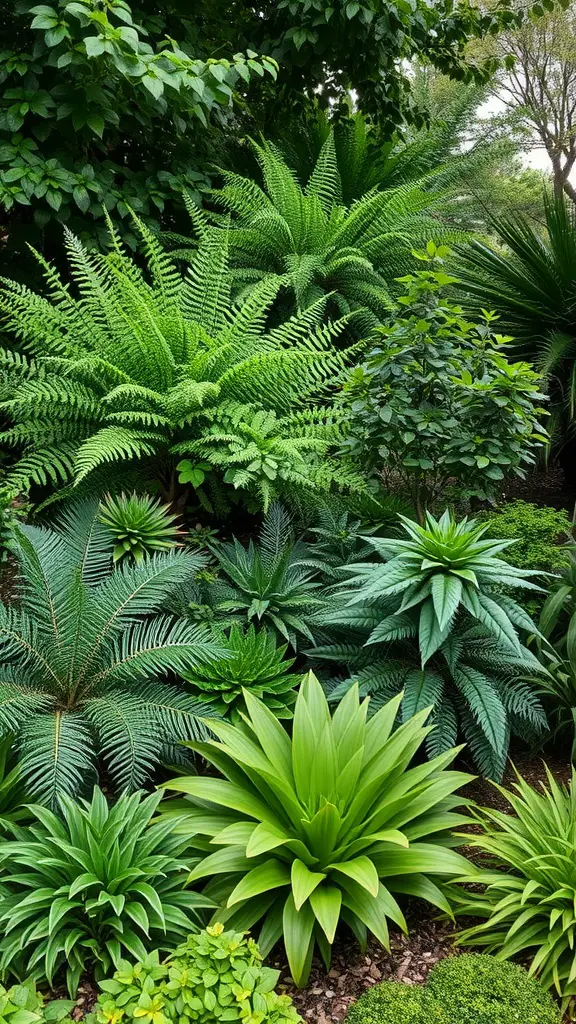
Crafting a shade garden presents a rewarding challenge, particularly when layering plants to create visual depth. The image highlights a vibrant tapestry of foliage, demonstrating a well-considered plant arrangement.
Crafting a stunning garden involves blending plants with diverse heights, forms, and textures. Observe how the taller ferns establish a vibrant background. The shorter, denser plants in the front add depth. This layering method captivates the viewer, giving the garden a more spacious feel. Consider these elements for a modern, eye-catching garden design in 2025.
Incorporating diverse leaf shapes elevates visual appeal. The expansive, striking foliage of bigger plants offers a stunning counterpoint to the refined fronds of ferns, resulting in a vibrant aesthetic. This interplay amplifies your shade garden’s allure and encourages closer inspection.
Remember to select plants with staggered bloom times for continuous color. Even in shady spots, vibrant blooms can contrast beautifully with greenery. Adding flowers injects color and vitality, ensuring your garden is a source of joy throughout the year.
Lastly, think about leaf colors. Green is common, but some plants boast variegated leaves. Others offer diverse green shades, boosting visual depth. Combining these aspects turns a basic shade garden into a welcoming retreat.
Seasonal Color Changes in Shade

Shady gardens offer unique beauty, particularly with seasonal color shifts. This image perfectly displays diverse plants and their lively colors. Deep greens, sunny yellows, and intense reds breathe life into these shaded spaces.
The changing seasons dramatically alter the appearance of these plants that thrive in the shade. Spring unveils vibrant new green growth. Summer brings forth a spectrum of warm hues. Autumn explodes with breathtaking reds and oranges, fostering a comforting ambiance. Winter might leave some plants bare, yet their underlying structure persists, presenting a unique form of elegance.
Selecting suitable plants is crucial for a thriving shade garden. Hostas and heucheras offer vibrant foliage, creating a rich, textured foundation. Incorporating flowering varieties will introduce pops of color, boosting your garden’s beauty all season long. Consider these options for a stunning 2025 garden.
A thoughtfully designed shade garden offers vibrant color and interest throughout the year. Combine diverse textures and shades to create an engaging and welcoming space.
Creating Cozy Seating Areas
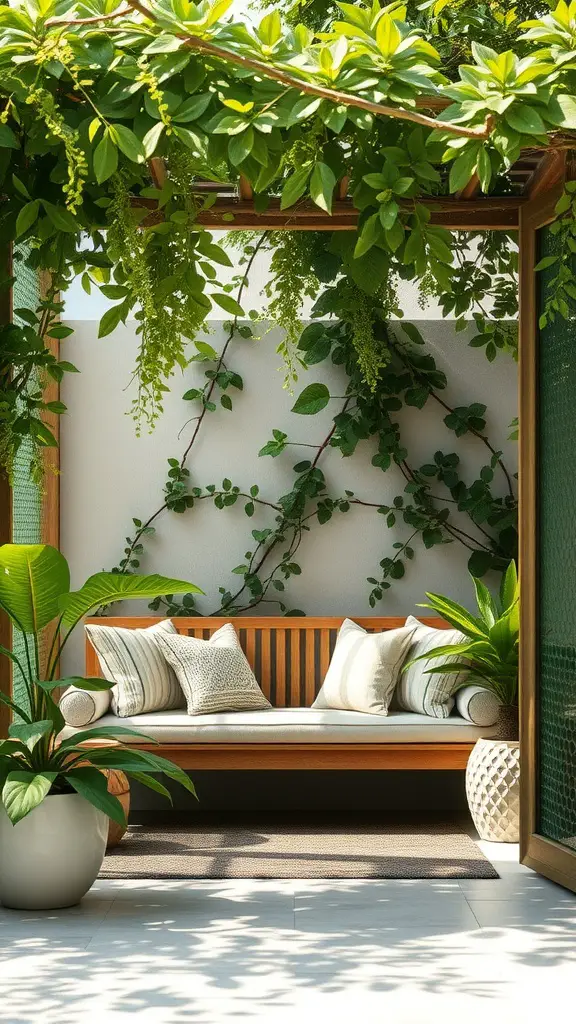
Transform your shady garden into a peaceful haven with well-placed seating. This picture showcases a charming seating area nestled beneath vibrant green foliage. It’s an ideal spot for unwinding or reading your favorite novel. Imagine enjoying this tranquil space in 2025!
Sink into relaxation on this bench, featuring plush cushions and calming neutral hues. Lush greenery surrounds you, injecting vibrancy and serenity into the space. Enhance your comfort further with inviting, soft pillows.
Adding plants, such as vines or leafy greens, fosters a more private and cozy atmosphere. Use climbing plants or hanging baskets to achieve this. They offer shade and enhance the visual appeal of your space.
Update your outdoor space with stylish flooring! A plush rug defines the area and provides comfort. Select durable, weather-resistant materials that are also welcoming. Transform your shaded garden corner into an ideal place for morning coffee or evening get-togethers.
Structural Elements: Arches and Trellises
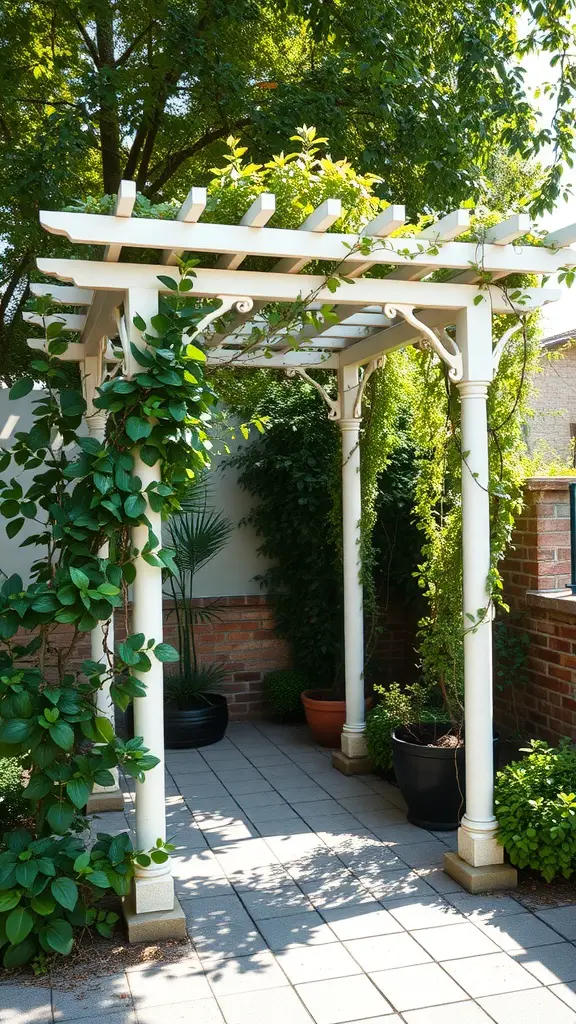
Elevate your 2025 shade garden with impactful structural features. Consider arches and trellises to transform your space. The featured trellis, draped in vibrant foliage, offers a tranquil and welcoming ambiance. This design element introduces personality and boosts vertical appeal within your garden.
A trellis offers vital support for climbing plants, enabling robust growth and offering welcome shade. This is especially beneficial in gardens where you desire cool, relaxing areas. Sunlight dappling through the foliage creates a serene atmosphere, ideal for peaceful afternoons.
Furthermore, these features clearly delineate walkways and relaxation spots. The appealing archway pictured provides a seamless shift between garden zones, leading guests through the vibrant greenery. It’s an excellent method to capture attention and inspire discovery.
As you craft your garden design, think about using trellises to highlight your prized plants. They can also form a secluded spot perfect for relaxing with a book. You can paint these structures or keep their natural look to complement your garden’s style. Ultimately, arches and trellises boost both the visual appeal and practical use of your shaded garden.
Using Boulders and Stones in Design

Boulders and stones are key elements in crafting stunning shade gardens. They introduce texture, define structure, and evoke a feeling of organic elegance. The picture highlights a beautifully designed pathway. It uses diverse stones and boulders to draw your gaze through a vibrant, verdant setting.
Massive rocks introduce a robust, natural ambiance, anchoring the space. Their scale and form enhance visual appeal, contrasting with the greenery and highlighting nearby plants. This blend of solid and delicate components is crucial for a harmonious garden design.
A stone pathway meanders through the garden, beckoning exploration. This design efficiently guides visitors while maintaining practicality. The contrasting textures of stone and lush greenery elevate the garden’s visual appeal.
Adding rocks to your garden offers real-world advantages. They improve water drainage and create homes for tiny animals. Best of all, they need minimal upkeep compared to plants. If you’re looking to enhance your shady garden with visual interest, think about using large rocks and stones as a central design element.
Creating a Wildlife Friendly Shade Garden

Crafting a shade garden? Attracting wildlife should be a key consideration. This image displays a lively garden bursting with colorful blooms and dancing butterflies. This vibrant scene enhances beauty and actively supports local ecosystems.
Using local plant species is an excellent strategy for attracting wildlife. These plants offer essential resources like food and safe havens for diverse creatures, such as butterflies and bees. The vibrant blossoms pictured, including pink lilies and yellow flowers, draw in pollinators, transforming your garden into a lively ecosystem.
Creating varied layers with plants of different heights and species enhances your garden’s appeal. This variety supports a wider range of wildlife. Taller plants become bird perches, while ground-hugging plants shelter insects. The vibrant greenery in the picture perfectly illustrates this beneficial combination.
Lastly, think about including water features such as bird baths or tiny ponds. These are vital for numerous animals and will attract them to your garden. The vibrant scene in the picture shows how a thoughtfully designed shade garden can transform into a haven for local wildlife.
Incorporating Tree Canopies
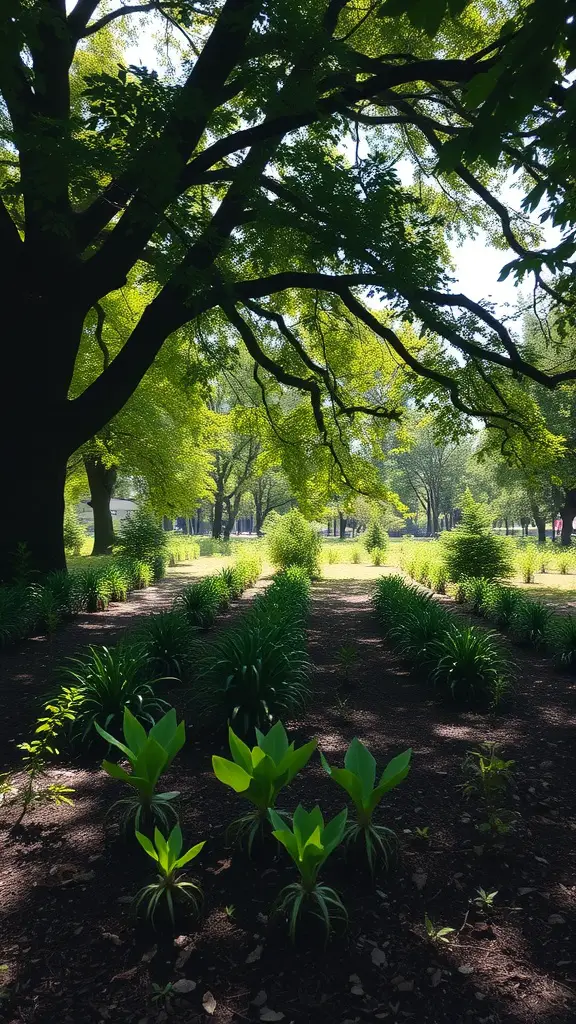
In 2025, tree canopies remain essential for shade gardens. They form a natural, light-filtering roof, creating a peaceful space for both plants and people.
The photo showcases a vibrant, green overhead foliage, offering generous shade. Below, diverse plant life flourishes. This equilibrium of sunlight and darkness is key to a successful shade garden, as of 2025.
Crafting your garden design? Think about trees that offer shade and enhance the plants below. Combining various tree types boosts visual interest and supports a thriving ecosystem.
The plant arrangement showcases a well-considered design. Observe the plants’ neat rows, ensuring easy access and upkeep. This layout invites exploration and enhances the garden’s appeal.
Adding tree canopies boosts beauty and forms microclimates. These microclimates control garden temperature and humidity. This simplifies growing plants that thrive in shade. A thoughtfully designed tree canopy turns a simple garden into a tranquil escape.
Utilizing Vertical Space in the Shade

Maximize your limited space with vertical gardening, ideal for shady spots. This image showcases climbing plants beautifully adorning a wooden fence. The vibrant green foliage transforms a shaded area into a lush, eye-catching display.
Maximize your indoor gardening by using vertical space! Cultivate diverse plants that flourish even with minimal sunlight. Explore options like climbing vines and stylish wall planters. The thriving plants pictured demonstrate their adaptability to shade, adding lush texture and vibrant greenery to your home in 2025.
Think about using trellises or wall grids for climbing plants. This saves space and boosts your garden’s look. Combine various plants to add layers and depth. Even dark areas will feel vibrant.
Furthermore, plants cascading over edges soften harsh lines. They also create a more relaxed outdoor vibe. Combine these with ground cover to boost aesthetics. This ensures every garden inch is used effectively.
Lighting Techniques for Nighttime Ambiance
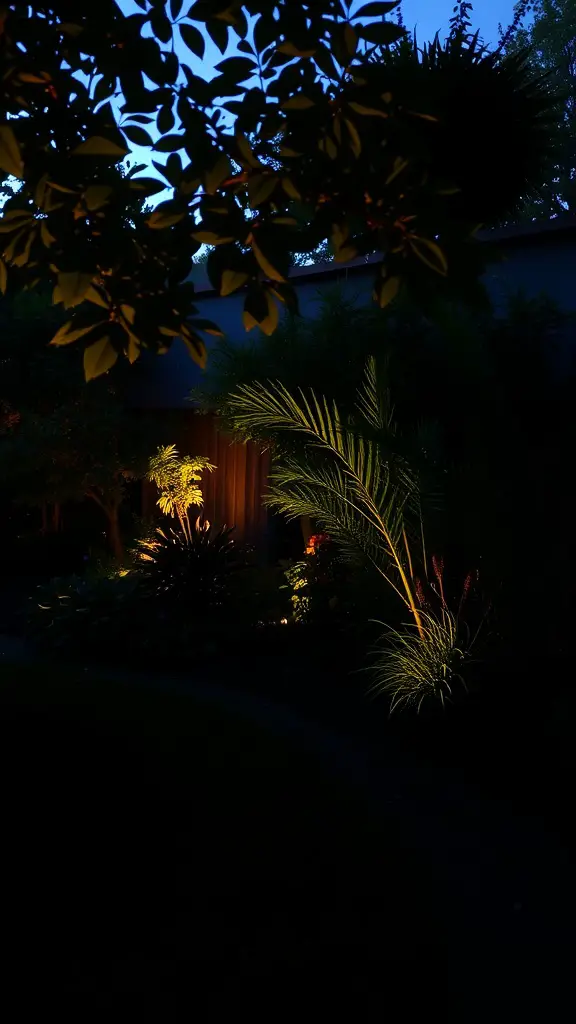
Turning your garden into a magical nightscape involves smart lighting. It’s about showcasing your plants and crafting a welcoming vibe. The picture shows a garden with expertly placed lights. These lights emphasize its best features. The gentle light enhances the greenery. This creates a peaceful setting for relaxing evenings.
Combine various lighting styles for a more vibrant effect. Spotlights highlight chosen plants, while ambient light gently illuminates the surroundings. This blend improves the garden’s beauty and adds dimension and intrigue to the area.
Opt for warm-toned lights to create an inviting atmosphere. The lighting showcased enhances the greenery and delicate hues of the plants, giving them a vibrant nighttime presence. Experiment with light placement at different levels to generate interesting shadows and depth in your garden.
Furthermore, illuminate garden paths with subtle lighting or charming lanterns. This guides visitors and introduces a magical element. A beautifully lit garden encourages exploration and appreciation of nature’s splendor, even after sunset.
Creating a Fern Centerpiece

Ferns offer a fantastic method for crafting a vibrant focal point in your shaded garden. This image displays diverse fern species, each boasting unique green tones, enriching your garden’s depth and texture. The bright, yellow-green ferns pop against the deeper green backdrop, establishing a captivating centerpiece.
Crafting a fern centerpiece? Try blending various fern species. The image showcases how the ferns’ fine, airy foliage creates a stunning contrast. This approach boosts visual appeal and promotes plant diversity in your green space.
Begin crafting your fern centerpiece by choosing a variety of shade-loving ferns. Plant them together in groups to replicate their native environment. Incorporate decorative stones, as shown. These stones add visual appeal and help the soil stay moist.
Keep your ferns consistently hydrated and pay close attention to their light requirements. A shady spot works best, shielding them from harsh, direct sun. Proper care will help your fern centerpiece thrive, creating a peaceful sanctuary in your garden.
Incorporating Colorful Bark Trees

Trees with vibrant bark offer a striking addition to any shaded garden. They infuse personality and a distinctive flair, contrasting wonderfully with the verdant greenery. As seen in the picture, these trees boast diverse bark textures and hues, creating a visually appealing richness that enhances the surrounding plants.
Choosing the right tree? Think about paperbark maple or river birch. They offer shade and add unique colors to your garden. The smooth, light bark contrasts beautifully with darker, rougher textures. This creates a visually appealing and dynamic landscape.
Beyond their beauty, trees with vibrant bark can become stunning centerpieces in your garden. Place them carefully to attract attention and add dimension. Combining them with plants that thrive in shade will amplify their charm, creating a unified and welcoming space.
Consider how the seasons impact your trees. Bark textures and colors often shift, boosting your garden’s visual appeal. Plant diverse tree species to maintain year-round interest and beauty.
Designing with Native Shade Plants

Transform your yard into a stunning shade garden with native plants. The picture showcases a charming area sheltered by a large tree, providing ample shade. This natural cover encourages shade-tolerant plants to flourish, bringing vibrancy and beauty to your garden in 2025.
Observe the striking, slender flower stems emerging from the vibrant foliage. These plants add vertical appeal and enhance the garden’s aesthetic. The interplay of leaf and flower textures results in a lively and engaging garden atmosphere.
The atmosphere is serene and welcoming. The backdrop features architecture harmonizing with the natural environment. This suggests a place for relaxation and appreciation of the surrounding beauty. Incorporating native shade plants around the area helps sustain local wildlife and minimizes water usage.
In 2025, this garden design exemplifies how indigenous shade-loving flora can convert a basic area into a vibrant sanctuary. Whether you’re crafting your personal garden or appreciating nature’s allure, recall that employing shade-tolerant plants fosters an inviting ambiance.
Selecting Perennials for Longevity

Crafting a stunning shade garden? Selecting the perfect perennial flowers is essential for long-term success. This image highlights beautiful options like daisies and zinnias, ideal for brightening shady spots. These resilient plants offer vibrant color and thrive with proper care, ensuring a flourishing garden for years to come.
Choose perennials celebrated for their resilience in dim environments. Hostas and ferns are superb selections, flourishing naturally in shaded areas. Integrate a blend of flowering and leafy plants to craft a dynamic garden that evolves throughout the year, mirroring the vibrant scene in the picture.
Think about how much care each plant needs. Some need frequent watering and pruning. Others are easy to care for and need little attention. Finding this balance is key to a garden that lasts and saves you work.
Finally, cluster plants with matching needs for optimal watering and feeding. The vibrant flowers in the picture are a small sample of choices. Discover different pairings to perfectly suit your shaded garden in 2025.
Creating a Sense of Enclosure

A thoughtfully planned shade garden offers a tranquil escape. This image perfectly embodies that idea. The curved pathway guides you through vibrant greenery. Towering plants and trees form a natural screen, fostering a sense of seclusion. The design encourages discovery and ensures a private, peaceful experience. Updated for 2025, this concept remains timeless.
Curved pathways are essential for crafting an enclosed feel. Soft curves, instead of harsh lines, naturally guide your gaze. They invite exploration and reveal the garden’s hidden gems. This design choice fosters a more personal and private atmosphere.
Using diverse plants introduces texture and amplifies the immersive natural experience. The bright greens beautifully contrast with the path’s earthy hues. Consider layering plants to create visual depth and boost the secluded ambiance.
Furthermore, consider using trellises or arbors to delineate distinct areas in your garden. These features support climbing plants, introducing vertical appeal and crafting cozy, protected nooks. In conclusion, this design exemplifies how careful planning can convert a basic garden into a serene retreat.
Designing for Low Maintenance
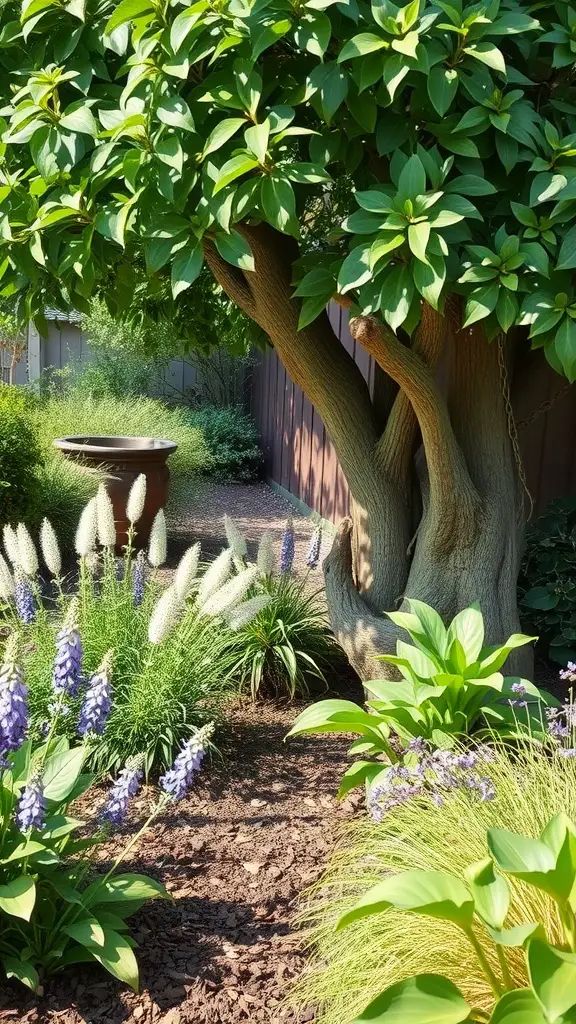
Building a simple shade garden is incredibly satisfying. Watch as it effortlessly transforms your outdoor area. The picture displays a beautiful mix of vibrant plants and flowers. It shows how easy it is to design a low-upkeep garden.
The tree creates a natural umbrella, offering vital shade for plants underneath. This is crucial for an easy-care garden. Choose shade-loving plants that need less water and attention. The vibrant purple flowers add beauty and attract helpful pollinators.
Mulching your plants conserves water and fights weeds, simplifying maintenance. Blending decorative grasses with vibrant flowers creates a visually appealing, low-effort garden. Enjoy a peaceful outdoor area without the need for constant care. This approach offers a relaxing retreat with minimal upkeep.
Think about incorporating stone or terracotta accents to elevate your garden’s aesthetic. A strategically placed pot, similar to the one in the background, works wonders. These elements create visual interest, complement the plants, and require minimal upkeep.
Mixing Edibles and Ornamentals

Transform your shady garden into a thriving oasis by combining edible and ornamental plants. This picture highlights a stunning display of colorful flowers and leafy vegetables, proving the incredible diversity possible in a single garden.
Observe the towering, purple allium, a vibrant focal point among the green foliage. This eye-catching flower provides a splash of color and serves as an excellent companion plant for adjacent herbs or vegetables. Integrating plants such as this enhances visual appeal and attracts beneficial insects to your garden in 2025.
Observe carefully! You might discover edible leafy greens. Mint and parsley, for example, flourish in shady spots. Their bright leaves enhance the decorative plants. This creates a visually appealing, multi-layered garden.
Combining diverse plant species boosts your garden’s biodiversity. Homeowners gain a distinctive and practical garden. It offers fresh meal ingredients and visual appeal. Envision yourself in this garden, harvesting herbs or adding edible flowers to salads!
Therefore, if you’re a beginner or want to refresh your garden, think about this method. Integrating decorative and edible plants can turn your shaded spots into a charming haven. It provides both aesthetic appeal and practical benefits.
Incorporating Garden Art and Sculptures
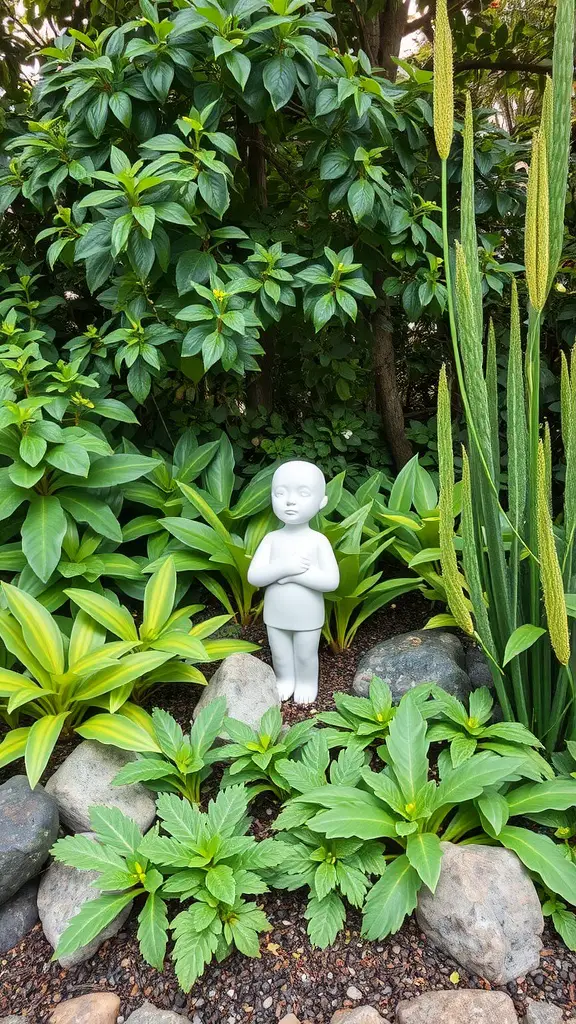
Elevate your shade garden in 2025 with captivating art and sculptures. This image showcases a delightful white sculpture. It’s perfectly placed among lush greenery, creating an eye-catching centerpiece. This artistic touch adds personality and sparks interest. It enhances the garden’s natural charm without overpowering it.
Incorporating art elevates your garden’s beauty. The juxtaposition of a sculpture’s clean, contemporary form against vibrant foliage achieves perfect harmony. This blend transforms shaded areas into captivating and welcoming spaces.
Think about pairing diverse sculpture materials and designs with your plants. From playful characters to modern forms, each sculpture showcases your unique taste and garden aesthetic. The sculpture’s white hue creates a stunning visual against the vibrant foliage, especially in shaded areas.
Consider your art’s location carefully. Placing it with plants, as shown, lets it connect with nature. This attracts attention and sparks curiosity. Adding art in this manner elevates a basic garden into a captivating journey.
Creating Playful Color Combinations

Elevate your shade garden design with vibrant color pairings. This image showcases a stunning plant combination. Observe the striking contrast between the dark purple, spiky foliage and the bright reds and yellows of the surrounding plants. This creates a visually appealing and dynamic garden display, perfect for 2025 trends.
This design thrives on expertly layered colors. The rich, crimson hues of the coleus create a welcoming foundation. Vibrant yellow and orange blossoms then burst forth, immediately capturing the eye. Finally, a spectrum of green foliage adds dimension and tactile appeal, enriching the overall color scheme.
Embrace experimentation in your garden! Combining plants with diverse leaf textures and vibrant colors creates captivating visual interest. Imagine the bold, rounded leaves of yellow blooms juxtaposed against the delicate, grass-like foliage – a truly striking contrast.
Employing complementary colors ensures a harmonious aesthetic. Seek out plants featuring analogous or contrasting tones to amplify your garden’s charm. Pairing warm and cool shades, such as red blooms alongside verdant foliage, infuses your shaded area with vibrancy and allure.
Integrating Seasonal Bulbs
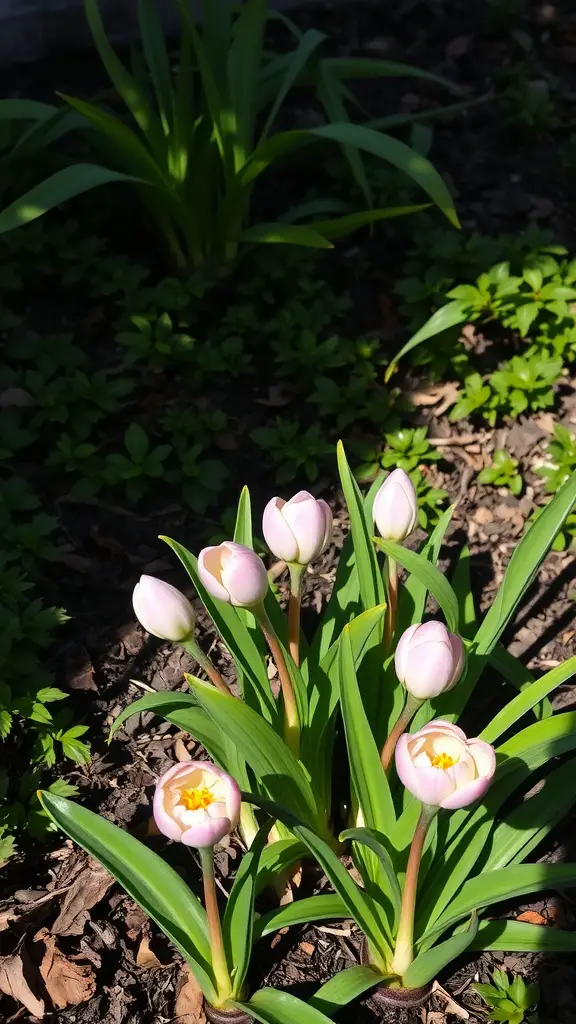
Shade-loving bulbs offer beauty and vibrant hues to your garden. The picture showcases lovely pink tulips emerging from lush greenery. These blooms are ideal for brightening shady spots with a burst of color.
Design your 2025 garden with spring-blooming bulbs. Think tulips and daffodils for a vibrant post-winter display. Plant them among your green foliage for a natural aesthetic. The bright flowers against the dark leaves offer a stunning visual contrast.
Consider bulb companions for a stunning garden! Ground cover plants beautifully complement bulbs. As seen in the image, healthy ground cover retains moisture and controls weeds. This pairing creates a vibrant and welcoming shade garden in 2025.
Successful seasonal bulb integration hinges on precise timing and careful planning. Plant your bulbs during autumn to guarantee stunning spring blossoms. This ensures a lively, evolving garden that harmonizes perfectly with the changing seasons.
Planning for Natural Drainage
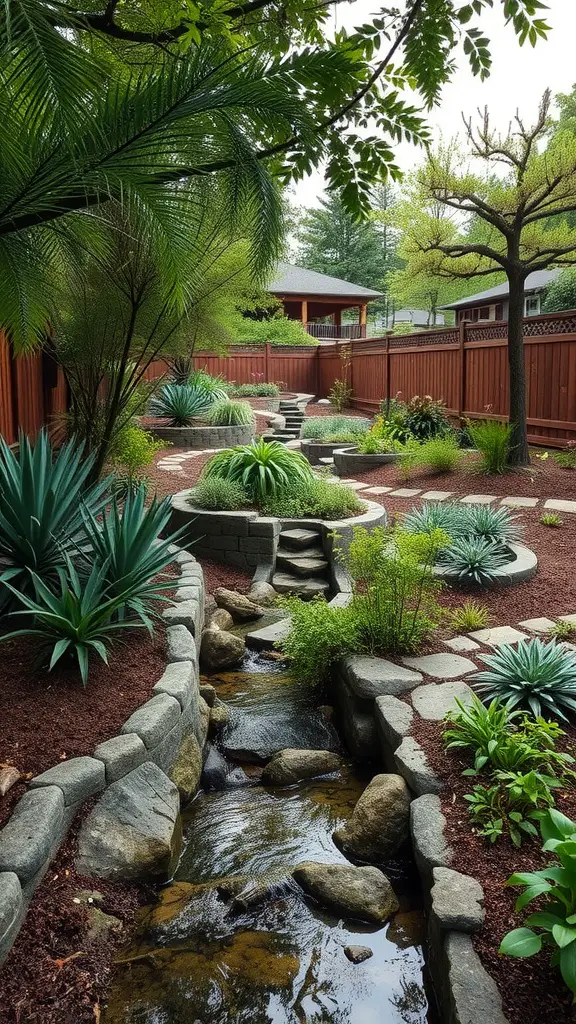
Effective shade garden design starts with understanding natural drainage. The featured landscape showcases a charming stream meandering through the area. This enhances the visual appeal and efficiently controls water runoff.
Stone pathways and borders expertly channel rainwater towards the stream. This design effectively prevents water accumulation, promoting a thriving garden. Opting for natural materials, such as stones, is key. It creates a seamless aesthetic while guaranteeing optimal drainage performance.
Observe the vibrant greenery surrounding the stream. These plants naturally soak up extra water and bring vitality to your garden. Choosing plants that flourish in damp environments will boost your garden’s aesthetic appeal and improve drainage.
Consider your garden’s slope when designing your layout. Directing water flow towards your drainage solutions ensures a flourishing shade garden quickly!
